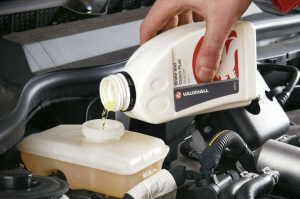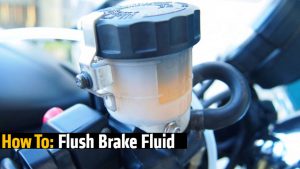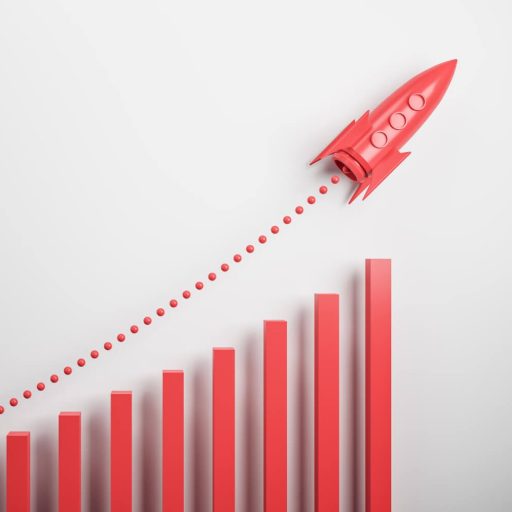Brake Fluid
Brake fluid is a hygroscopic fluid that starts to absorb water, making it less effective. For best results, flush your brake fluid once a year. However, if you do a lot of hard braking, it would also make sense to bleed your fluid once every six months. Whenever you brake hard, the brake rotors build up a great deal of heat, which “boils” the brake fluid and creates air bubbles. The act of bleeding the brakes helps to remove air bubbles from the system.
If you want to flush or bleed your brakes, make sure to have fresh brake fluid on hand. During bleeding/flushing, if there is too little fluid in the reservoir, it will induce air into the system making the process ineffective.
So, make sure that the car brake fluid is fresh and in case the seal has been opened, ensure that fluid hasn’t been sitting on the shelf for more than 2 weeks. This is really important to check as opened brake fluid will contain moisture. Unlike other brake components, such as brake pads or brake rotors, brake fluid is sensitive to shelf life and is especially vulnerable after an open container is used. Moreover, make sure to wear safety glasses during the whole operation and use proper equipment.
You may also like to learn about updated automotive blogs.
What Is Brake Fluid Flush?
The car braking system has many working parts. Generally, it has disc brakes or drum brakes either in the front or back. Everything is linked by a system of tubes and hoses that link the brakes at each wheel to the master cylinder. Additionally, the power brakes, parking brake, and anti-lock system are also a part of the brake system.
By applying pressure to the brake pedal, a plunger presses on the master cylinder, forcing brake fluid through the connected hoses to each brake. When you use disk brakes, fluid is forced into a caliper, where it squeezes against a piston, which slows or stops the wheel. Whereas with drum brakes, the brake shoes are pushed against the drum to stop the wheel as the fluid is forced into the wheel cylinder. In both scenarios, brake fluid has been playing a vital role in your vehicle’s brake system.
During the deterioration of your brake system, small pieces of rubber, rust, and other debris can fall into your brake fluid. When the fluid gets dirty, you will notice that your brake fluid becomes less effective and in the end, won’t work. Also, as it has been discussed early that brake fluid is hygroscopic, it absorbs 3% of weight each year in water, which makes the brake fluid flush even more important.
A brake fluid flush is basically used to take all the old, dirty brake fluid out of your system and replaces it with clean and fresh fluid. So, do regular maintenance including brake fluid flush as it is extremely important for your car and it should be done every 30,000 miles or every two years.
Additionally, it’s a good idea to check the brake fluid level periodically. As low brake fluid can have an adverse effect on the effectiveness of your braking system.

Why Does Car Brake Fluid Wear Out?
Brake fluid absorbs water very rapidly due to its chemical design, which means it is hygroscopic. Consequently, this can cause problems in the brake system, as all the parts, such as the brake master cylinder, calipers, lines, proportioning valves, and ABS system, are made from aluminum or steel, metals that corrode when exposed to water. There is no doubt that brake fluid is one of the most ignored fluid changes on your car, with some cars failing until the brake component is changed and fluid is flushed. Don’t let that happen!
The brake system fluid absorbs moisture whenever it comes into contact with air, and its color changes over the course of thousands of miles from clear to rusty brown, as corrosion develops inside the brake system.
However, the more water in the fluid, the lower the boiling point of brake fluid becomes and the more corrosive it gets. In fact, corrosion is the top reason why calipers and wheel cylinders begin to seize because corrosion forms inside the cylinder bore with the contaminated fluid.

How Does a Brake Fluid Flush Work?
Changing brake fluid on your own is possible, but a mechanic with a brake-flushing machine is able to do it more quickly and thoroughly. Still, if you decide to do it by yourself, then make sure to use high-quality brake fluid. Also, outside air can contaminate brake fluid quickly, thus causing it to combine with water vapor. Such contamination can ultimately result in system damage, so take care.
If you visit your vehicle in the shop, firstly, the expert technicians will locate the brake fluid reservoir and after that remove all the old fluid before replacing it with the new fluid. Once it has been done, in order to remove the old brake fluid, you will need to lift your car up and remove all four wheels. The fluid is flushed by connecting tubing to the brake valve on one end and emptying into a container on the other end.
During this process, the second technician will pump the brakes and hold down the brake pedal while the other technician opens the valve. Then, the car’s old brake fluid should be emptied into the container. The color of the old brake fluid is dark, whereas the new fluid color is a yellow tint.
The “flushing” process would be repeated until it shows the signs that the new and clean fluid is reaching the brakes. Continue repeating this process for all four brakes before putting back your car wheels in the right place. You can then perform a road test to ensure that the brakes are operating properly. Generally, the brake fluid flush costs around $100.
Moreover, brakes are one of the most important parts of the system of your car, next to the engine itself. As time passes, the components of the brake system start deteriorating. If you regularly change your brake fluid, it will make your ride safer and will extend the lifespan of your brake components.
How to Flush Brake Fluid
Have you people ever heard about brake fluid flush? What is it and what is its importance? Do you really do it?

Step 1: Empty The Master Cylinder Reservoir
Firstly, remove all the fluid that is currently available inside the master cylinder reservoir. You can do it in a number of ways. But, using a large syringe, turkey baster, small siphon pump, or transfer pump and tube will take a matter of minutes to remove all the fluid from the reservoir while the car is off and in the park, without putting any pressure on the brakes.
Step 2: Fill and Bleed
The next step is to fill the reservoir with fresh and clean fluid. From here, there is a no different process than bleeding brakes. When the old fluid is completely removed, a small, 2-foot section of clear tubing is wrapped around the bleeder screw to make it easier to see the results. Let’s start with the rear of the car and bleed out the both 2 rear brake calipers/wheel cylinders. After the old fluid has been removed, you will see new, clear fluid flowing through the tube in place of the rusty, brown liquid. Next, bleed the front wheels, making sure to recheck the master cylinder reservoir after bleeding each wheel.
Step 3: Top It Off
Then, after you’ve completed your last wheel, fill the reservoir back up to the fill line.
How Often Brake Fluid Should Be Changed?
A great question, the one that answers is frequently debated since it has the distinction of being one of the few fluids that car manufacturers do not usually recommend changing. The good practice is to change your fluids every three years or every 30,000 miles.
All the parts and tools you need to flush your brake fluid are available at the car repair shop. So, visit us to get all of the parts and tools you need to get the job done right. In case you don’t have the mechanical skills, you can bring them to one of our Preferred Repair Shops in your area.










